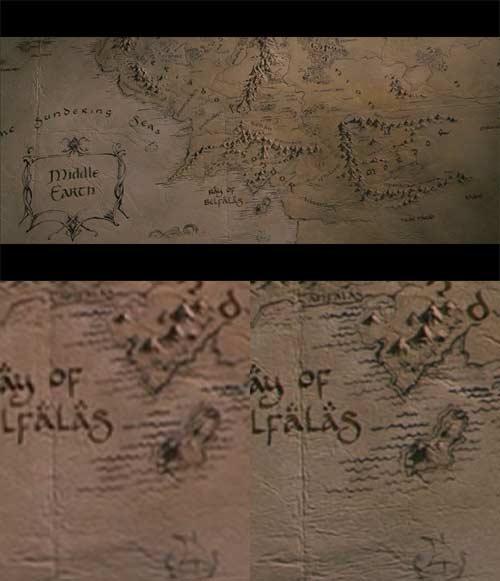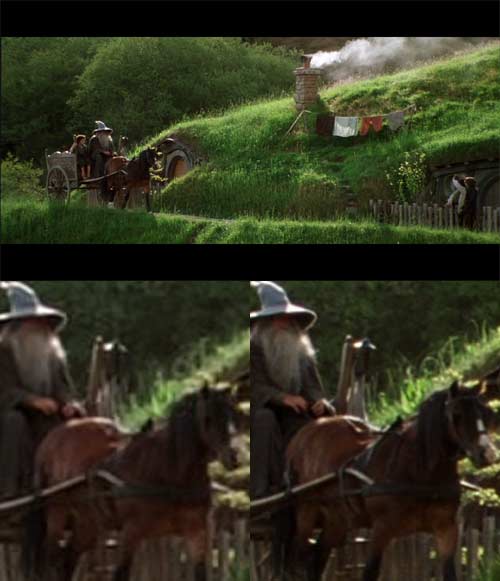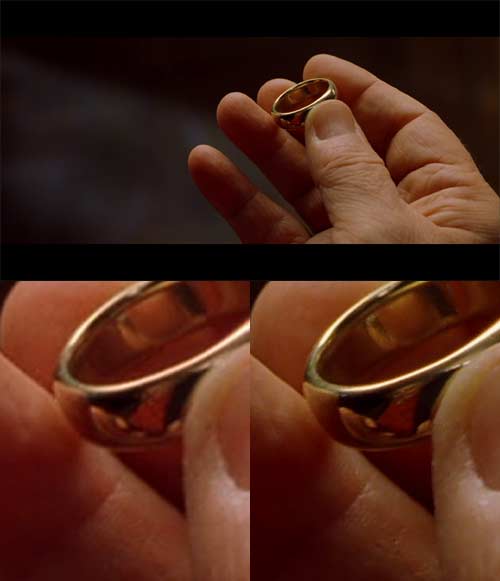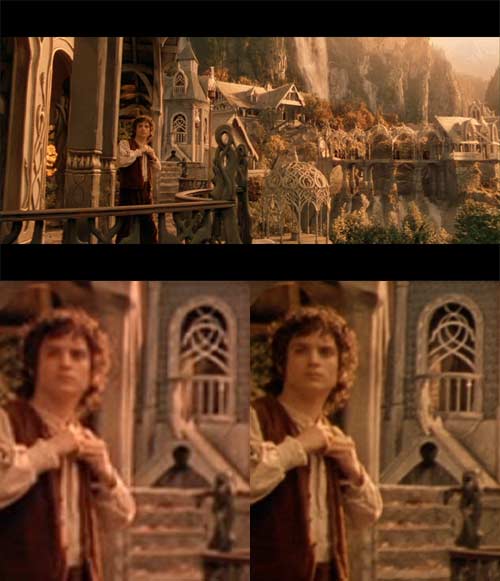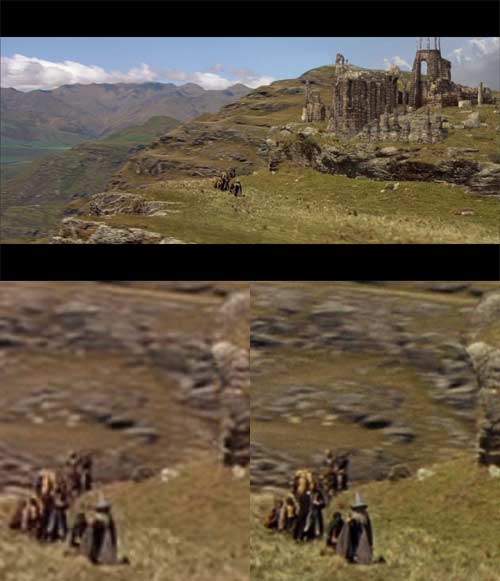 Picture:
Picture:  Sound:
Sound:  Extras:
Extras: 
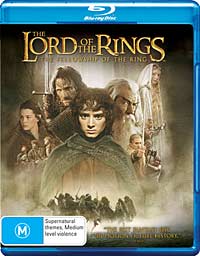
Movie:  Picture:
Picture:  Sound:
Sound:  Extras:
Extras: 
I'm not great fan of fantasy, but even for me Peter Jackson's The Lord of the Rings trilogy is a tour-de-force. A road movie of sorts, it is also deeply moving. This is a fantasy movie (okay, three movies) for both the fantasy lover, and for those normally uninterested in the genre.
Originally proposed by Jackson as a two film adaptation, for a while financial considerations threatened to chop it down to a single two hour movie. Ultimately New Line Cinema picked it up and suggested that three movies would be more fitting for a three part book. Costing close to $US300 million for the three parts (pretty reasonably considering the total running time of well over nine hours), it ended up pulling in close to $US3 billion internationally at the box office.
At the time of production New Line Cinema was owned by Time Warner, which also owns Warner Bros. Generally New Line films are distributed in Australia by Roadshow Entertainment, which also distributes some Warner titles (eg. The Matrix movies). But while the Warner titles are normally identical to the US versions in every way, Roadshow's New Line titles are normally localised, evidenced by the disc opening with Roadshow's own logo, Australia-specific copyright warnings, and the disc being locked to Region B. That's the case with these ones.
But the actual encodes of the video and sound seem to be very similar to the US and German versions. As I write, there are two versions of these discs available in Australia. All can only be purchased as separate discs, not as a boxed set. And only the theatrical versions are available at this point. Jackson has said that the Extended Editions (which, together, add two hours more material) will be made available on Blu-ray at some point. However, Jackson himself apparently prefers the Theatrical versions.
The discs are also available through JB HiFi, each with a DVD of extras lifted from the relevant original release DVDs. However the basic releases -- which I am reviewing here -- are devoid of any extras other than some trailers).
So what do you get with these discs? Well, you get a clear sense that there will be plenty of room for the extra run-times of the Extended Editions. The entire contents of each of the three discs use, respectively, 81%, 79% and 77% of the capacity of a dual layer Blu-ray disc. So, perversely, the longer the movie, the less space used. Keeping the VC1 encoding system at average bitrates (again, respectively) of 23.35Mbps, 22.75Mbps and 19.14Mbps, the extra minutes can easily fit on the discs.
But I have to wonder: how did the disc encoders choose the amount of compression to use? Did they use some trial and error process, increasing the bitrate until they found a good-looking result? They certainly didn't just encode to a preset average (this is clearly possible, judging by the number of titles I see with average bitrates that look like 30.00Mbps). They clearly didn't encode to the maximum amount that could comfortably fit on the disc, or they could have added quite a few more bits into the mix.
It's a mystery.
Anyway, while some people berate studios that don't encode at 30Mbps+ for every title, I'm far more relaxed about it. Because these three movies show that as long as a reasonable bitrate is used (up around 20Mbps seems to be pretty safe), the actual value is unimportant. That's because with these three movies, the lower the average bitrate the better the actual picture quality!
And, no, I doubt very much it has anything to do with the encoding.
US reviews of the first instalment, The Fellowship of the Ring, have been near universal in expressing disappointment with the picture quality. In fact, I think their judgement has sometimes been biased by it not achieving the heights they had imagined for it.
But you will notice that I have given the this instalment four stars out of five. With that I'm trying to suggest that while the picture quality is by no means the best available, I think the encoding was very transparent. That is, that the disc is an excellent representation of a good print of the film.
The weaknesses in image quality -- primarily a certain softness in some scenes, such as the sections set in the Elvish capital -- I think were most likely production issues. It wouldn't be surprising if Peter Jackson and Weta Workshops, which did almost all the special effects, got better with practice. While the filming for all three instalments took place within the same period, the post production work was performed sequentially. Software was upgraded, the artistic judgements of the filmmakers became more critical, and people just got better at their jobs.
So accept that Fellowship is going to be imperfect. For the most part it lacks the texture and depth of the two later instalments. But it is far better on the eye than the DVD, especially with a front projector and a big screen. In fact, it is quite good enough for picture quality to be completely overlooked as you immerse yourself in the story. The picture is unlikely to get any better than this, in my opinion, because this Blu-ray just shows the source as it is.
As for the other two, The Two Towers offers a clearly visible improvement, while The Return of the King is better still when it comes to sharpness and detail. Blacks are decent throughout, and colour seemed good, although the palette was in large part under the control of the movie makers, and they used it for their own purposes.
What you can't ignore as you immerse yourself in the movie is the sound. I doubt that the 24 bits used added anything to a standard 16 bit encode, but either way the DTS-HD Master Audio, delivered in ES 6.1 format (with a matrixed surround back channel), was absolutely brilliant. What was nice was that it was not just well steered, not just full of appropriate and deeply extended bass, but that it was so clean that I was constantly tempted to turn up the system just that little bit more. The lack of distortion and harsh edges to the sound meant that I could go to very high volumes without any sense of wear and tear on my ears.
Truly lovely.
So there you have it: there is simply no way to watch The Lord of the Rings trilogy any more except on Blu-ray. And no serious Blu-ray collection can be considered complete without it.
 (Australian rating); Locked to Region B
(Australian rating); Locked to Region B
The following video bitrate graph was generated by BDInfo 0.5.3:
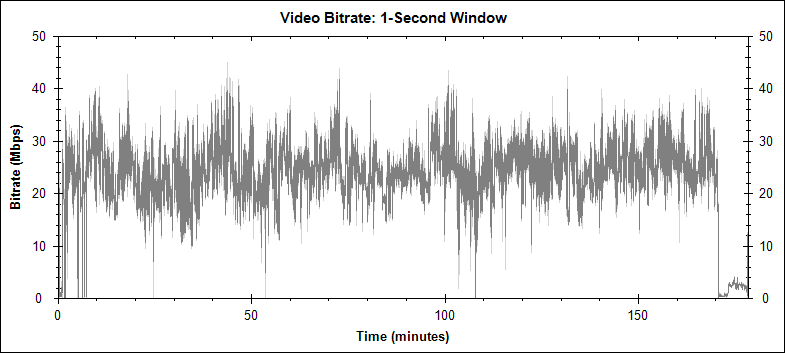
At the top of each is the full frame (suitably shrunk down) used in the comparison, with a 250 pixel wide detail from the frame underneath. The left side is from the PAL DVD. The image was captured digitally from the disc, scaled up from its native 720 by 576 pixel resolution to 1,024 by 576 (to present in the correct aspect ratio) by the application. I then scaled it, in order for it to be comparable to the Blu-ray version, to 1,920 by 1,080 pixels.
The detail is from that last scaled version, and has not been rescaled again. The right side is from the Australian Blu-ray. This has not been scaled at all. Different applications were used to capture the two frames, so some caution should be exercised in judging colour and brightness.
For visitors from NTSC lands, generally the PAL DVD is just a touch sharper than the NTSC DVD.
